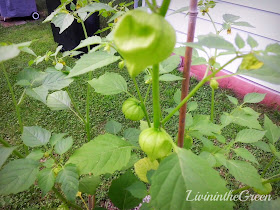Years ago I planted a decidedly non-trendy vegetable in the garden. I'm not sure why I was compelled to grow something that I had no idea what it was, but for me that was typical in my early gardening years. I was in the experimental zone with the garden as my laboratory and this promising new veggie was one of the first of my discoveries.
 |
| Tomatillo "Toma Verde" |
The plants grew. As a matter of fact, they more than grew. They made their presence very well-known in my small garden space and I wasn't able to keep up with their fruits. By the end of summer, I was pulling up seedling after seedling of this alien vegetable which was determined to take over the
I didn't even know what to do with them. I made up some salsa with them but was too afraid to eat it. But the whole episode was not a loss. I formed a connection with these super easy to grow plants that were prolific to boot. I would be growing them again and I did but not until many years later.
 |
| Tomatillos in early summer. |
Years later in the culinary scene, salsas were becoming "all the rage" and tomatillo plants were now showing up in garden centers (on purpose!) I had begun to cook with them, actually buying them at the store for my White Chicken Chili and Roasted Salsa Verde. So I decided to grow them again but realized I didn't have room for them in my small home garden and so I tried them at our community garden.
 |
| Early fruits and blooms |
They grew well but were infested by a caterpillar that destroyed practically every fruit. Bummer. I wouldn't spray my plants but decided to try them at our house again where the bugs weren't as voracious. This time I grew them in containers.
Tomatillos are a member of the nightshade family and are a distant relative of our red tomato. They originated in Mexico and are heavily consumed there after being fried, boiled or steamed. With the hot pepper trend beginning in the U.S. over the last 10 years, tomatillos became sought after for their tangy, slightly citrus-y flavor and of course their amazing color.
 |
| Tomatillos in containers; late summer |
Tomatillo fruits are covered by a thin husk that the fruit actually grows into after a small yellow flower blooms. The husks continue to grow until you get a nice golfball sized fruit that means it's perfect for picking.
When I started my seedlings, I use the same growing culture as for regular tomatoes and grow them alongside them by starting them indoors at the same time. The leaves of the tomatillo are definitely different than that of a tomato so no problem telling them apart.
Why plant in a container? Two reasons for me; first, I ran out of room in my garden and two, I didn't want their seedling volunteers to take over my garden then next year. Not that I don't love volunteers, but they are very happy to multiply when they are happy where they're grown. And besides, they grew very well in the 5 gallon pots I planted them in. I didn't do much, just watered and fertilized with an organic mix a few times over the summer and gave them lots of sun and heat. They did the rest.
A few pointers for growing them:
1. Make sure to plant more than one or two! I only planted one container the first year and got all blooms and one fruit. They need more plants in order to cross pollinate. I also made sure the leaves and blooms all intertwined with each other so the bees would have no problems hopping from one plant to the other. Four plants gave me enough for fresh eating as well as lots for freezing.
2. To freeze them: Pick the fruit when it fills out the husk but before it turns yellow. You can still use the yellow ones but the green ones are what you want. Peel the husks and compost. Lightly wash the fruit (they have a sticky substance on them) and dry. Then place in a freezer bag on it's side in the amount you need to use for a recipe. I used quart bags and filled them and placed a few hot peppers for instant salsa verde. They freeze unbelievably well and last a long time in a deep freeze. Just take them out to thaw, puree and cook when you need them.
So if you're a veggie risk-taker like me, then you'll love growing these plants and more importantly, you'll love eating them.
This is a great vegetable to add to your diet and perfect for a container garden! You can find growing guidelines here at Organic Gardening.
Happy planting and blessings!
Linked to these amazing blog parties...Farmgirl Friday












